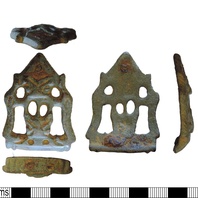
Viking Objects
Stirrup-Strap Mount (PUBLIC-ED7865)
This example of an Anglo-Scandinavian copper-alloy stirrup-strap mount is classed as a Williams Class B Type 2 and is decorated with openwork zoomorphic designs.
Read More
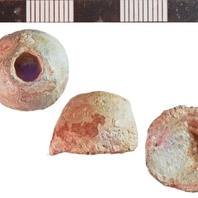
Viking Objects
Lead Weight (NLM-20FC79)
This cast lead weight has an empty apical hole which may have held something at some point. The mass may suggest this to have represented four Viking age units of 4.07gms, as used for silver bullion transactions. It is also possible that this object was used as a gaming piece and thus it could have served a dual purpose. Weights are an important form of evidence for Viking Age commerce and the use of standards across the different economic systems within which Vikings were integrated. Many of the weights discovered, particularly ones in Ireland and those of Arabic type, suggest that a standardized system of weights existed in some areas. These standard weights, alongside standard values of silver, are what allowed the bullion economy of Viking occupied areas to function. A bullion economy was a barter economy that relied on the exchange of set amounts of precious metal in various forms, such as arm-rings or coins, for tradable goods, such as food or textiles. Each merchant would have brought their own set of weights and scales to a transaction to make sure that the trade was conducted fairly.
Read More
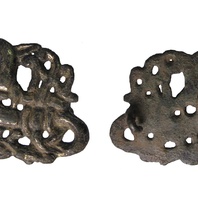
Viking Objects
Urnes-Style Brooch (LIN-F79A53)
This brooch has a gilded openwork zoomorphic design in the Urnes style. For more information on Scandinavian jewellery in England check out our blog: Brooches, Pendants and Pins: Scandinavian Dress Accessories in England.
Read More
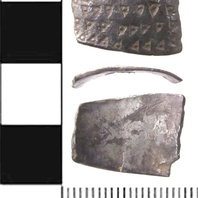
Viking Objects
Silver Arm Ring Fragment (SWYOR-58AFB4)
A fragment of an Early Medieval silver decorated arm ring with triangular punches each with a pellet in the centre. The object may represent hacksilver, but as it is broken rather than cut, this is not certain. Nonetheless, arm rings functioned as both a means of storing wealth as well as putting the wealth and status of the individual on display.
Read More
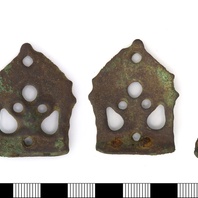
Viking Objects
Stirrup Mount (LEIC-113224)
Early medieval copper-alloy stirrup mount rectangular in form and cross section. The main decoration consists of a trilobed motif, cebntrally placed, which sits on a very short wide shaft running to the objects base. The mount is classified under Williams class B, type 1, group 3.
Read More
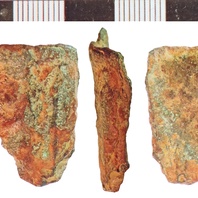
Viking Objects
Scabbard Chape (NLM-6C0242)
This possible scabbard chape fragment is very damaged but the reddish tint is often characteristic of Anglo-Scandinavian metalwork
Read More
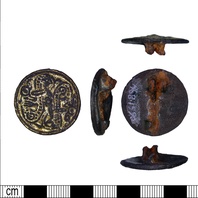
Viking Objects
Copper-Alloy Jellinge-Style Brooch (LEIC-36241D)
This brooch contains two S-shaped zoomorphic Jellinge-style designs around a central boss. For more information on Scandinavian jewellery in England check out our blog: Brooches, Pendants and Pins: Scandinavian Dress Accessories in England.
Read More
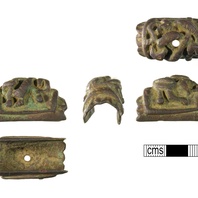
Viking Objects
Urnes-Style Sword Mount (WMID-2FF927)
A cast copper-alloy fitting with Urnes-style, zoomorphic decoration, found near Boylestone, Derbyshire. It may have been a pommel mount and, if so, would have showed off the wealth of the owner.
Read More
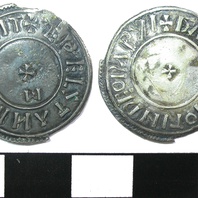
Viking Objects
Silver Penny (1914/543-1)
This silver penny of King Aethelstan, who was King of England from 927-939, was minted in Derby by the moneyer Gadierd between 937-939. It is not known where it was found. Moneyers were people who were permitted to mint money on behalf of the king. Minting coins was a way of controlling the means of exchange within a kingdom and which created a more easily administered standardized system of trade. Moreover, the coins themselves were often used as propaganda, portaying symbols and statements that gave off a desired message. The Vikings later used the minting of coins to legitimize their own rule.
Read More

Viking Objects
Coin of Cnut the Great (NARC-9AE391)
This silver Helmet IIIc Type penny was minted for King Cnut of England by the moneyer Eadwine in Thetford. The obverse displays + CNUT RECXA with a figure wearing a pointed helmet. The reverse displays + EDPINE ON DEOD and a voided short cross. Minting coins was a way of controlling the means of exchange within a kingdom and which created a more easily administered standardized system of trade. Moreover, the coins themselves were often used as propaganda, portaying symbols and statements that gave off a desired message. The Vikings later used the minting of coins to legitimize their own rule.
Read More
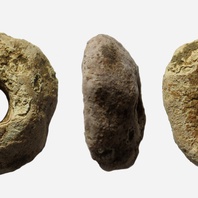
Viking Objects
Spindle-Whorl (LEIC-8D89EA)
A small, plain, undecorated lead-alloy spindle-whorl. Fibres were spun into thread using a drop-spindle of which the whorls were made of bone, ceramic, lead or stone and acted as flywheels during spinning.
